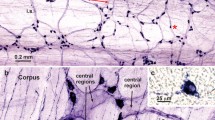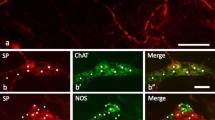Summary
Intraperitoneal injection of quinacrine (100 mg/ kg) into rats causes marked dilation of the cecum about one week after the injection, but the jejunum remains its normal size. The morphological changes induced in the myenteric plexus and the longitudinal and circular muscle layers of both the cecum and the jejunum have been examined by fluorescence and electron microscopy 1.5 h to 2 weeks after the injection.
In the cecum, 1.5 h after the injection, the granular fluorescence of quinacrine was apparent in many ganglion cells of the myenteric plexus and in the nerve fibers in the muscle layers. In connection with the granular fluorescence, numerous lysosomal dense bodies appeared in ganglion cells and axons, and subsequently the degeneration of the neurons was observed at ultrastructural level. The lysosomal dense bodies often contained many large granular vesicles of 95–140 nm in diameter. The number of lysosomal dense bodies in the axons was greatest 3–7 days after the injection. Although the axon type sensitive to quinacrine could not be specified, axons containing many large granular vesicles were the predominate type. Fibrosis in the outer longitudinal muscle layer was another characteristic resulting from quinacrine administration. Proliferation of the rough-surfaced endoplasmic reticulum and of the Golgi complex and a concomitant decrease in the number of myofilaments became evident in many smooth muscle cells 3–7 days after the injection; the intercellular spaces became enlarged 7 days after quinacrine administration. These changes and the dilation of the cecum showed considerable recovery 2 weeks after the injection. A similar distribution of quinacrine fluorescence, lysosomal dense bodies and fibrosis were found in the jejunum, though in lesser degree. We suggest that the neuronal and/or muscular alterations are prerequisites for the enlargement of the cecum and that the regional difference of the gut in terms of sensitivity to quinacrine is quantitative rather than qualitative.
Similar content being viewed by others
References
Allison AC, Young MR (1964) Uptake of dyes and drugs by living cells in culture. Life Sci 3:1407–1414
Ålund M, Olson L (1979) Depolarization-induced decreases in fluorescence intensity of gastrointestinal quinacrine-binding nerves. Brain Res 166:121–137
Ålund M, Olson L (1980) Quinacrine-binding nervous elements in intraocular grafts of intestinal smooth muscle tissue. Med Biol 58:45–48
Baumgarten HG, Holstein AF, Owman C (1970) Auerbach's plexus of mammals and man: Electron microscopic identification of three different types of neuronal processes in myenteric ganglia of the large intestine from rhesus monkeys, guinea-pigs and man. Z Zellforsch 106:376–397
Böck P (1980) Identification of paraneurons by labelling with quinacrine (Atebrin). Arch Histol Jpn 43:35–44
Böck P (1980) Adenine nucleotides in the carotid body. Cell Tissue Res 206:279–290
Cook RD, Burnstock G (1976) The ultrastructure of Auerbach's plexus in the guinea-pig. I. Neuronal elements. J Neurocytol 5:171–194
Crowe R, Burnstock G (1981) Perinatal development of quinacrine-positive neurons in the rabbit gastrointestinal tract. J Auton Nerv Syst 4:217–230
Crowe R, Burnstock G (1981) Comparative studies of quinacrine-positive neurons in the myenteric plexus of stomach and intestine of guinea-pig, rabbit and rat. Cell Tissue Res 221:93–107
Crowe R, Burnstock G (1982) Fluorescent histochemical localisation of quinacrine-positive neruones in the guinea-pig and rabbit atrium. Cardiovasc Res 16:384–390
Crowe R, Burnstock G (1984) Quinacrine-positive neurones in some regions of the guinea-pig brain. Brain Res Bull 12:387–391
Dupont JR, Jervis HR, Sprinz H (1965) Auerbach's plexus of the rat cecum in relation to the germfree state. J Comp Neurol 125:11–18
Gabella G (1972) Fine structure of the myenteric plexus in the guinea-pig ileum. J Anat 111:69–97
Gannon BJ, Noblet HR, Burnstock G (1969) Adrenergic innervation of bowel in Hirschsprung's disease. Br Med J 3:338–340
Iijima T (1983) Quinacrine-induced degeneration of non-adrenergic, non-cholinergic autonomic nerves in the rat anococcygeus muscle. Cell Tissue Res 230:639–648
Irvin JL, Irvin EM (1954) The interaction of quinacrine with adenine nucleotides. J Biol Chem 210:45–56
Keeler R, Richardson H, Watson AJ (1966) Enteromegaly and steatorrhea in the rat following intraperitoneal quinacrine (atebrine). Lab Invest 15:1253–1262
Köberle F (1963) Enteromegaly and cardiomegaly in Chagas disease. Gut 4:399–405
Komuro T, Baluk P, Burnstock G (1982) An ultrastructural study of nerve profiles in the myenteric plexus of the rabbit colon. Neuroscience 7:295–305
Krishnamurthy S, Kelly MM, Rohrmann CA, Schuffler MD (1983) Jejunal diverticulosis. A heterogeneous disorder caused by a variety of abnormalities of smooth muscle or myenteric plexus. Gastroenterology 85:538–547
Olson L, Ålund M, Norberg KA (1976) Fluorescence-microscopical demonstration of a population of gastrointestinal nerve fibres with a selective affinity for quinacrine. Cell Tissue Res 171:407–427
Smith B (1967) The myenteric plexus in drug-induced neuropathy. J Neurol Neurosurg Psychiat 30:506–510
Webster W (1974) Aganglionic megacolon in piebald-lethal mice. Arch Pathol 97:111–117
Zimmerman GR (1962) Megacolon from large doses of chlorpromazine. Arch Pathol 74:47–51
Author information
Authors and Affiliations
Rights and permissions
About this article
Cite this article
Iijima, T., Hasegawa, K. Quinacrine-induced dilation of the rat cecum and degeneration of large granular vesicle-containing neurons in the myenteric plexus. Cell Tissue Res. 241, 383–389 (1985). https://doi.org/10.1007/BF00217184
Accepted:
Issue Date:
DOI: https://doi.org/10.1007/BF00217184




